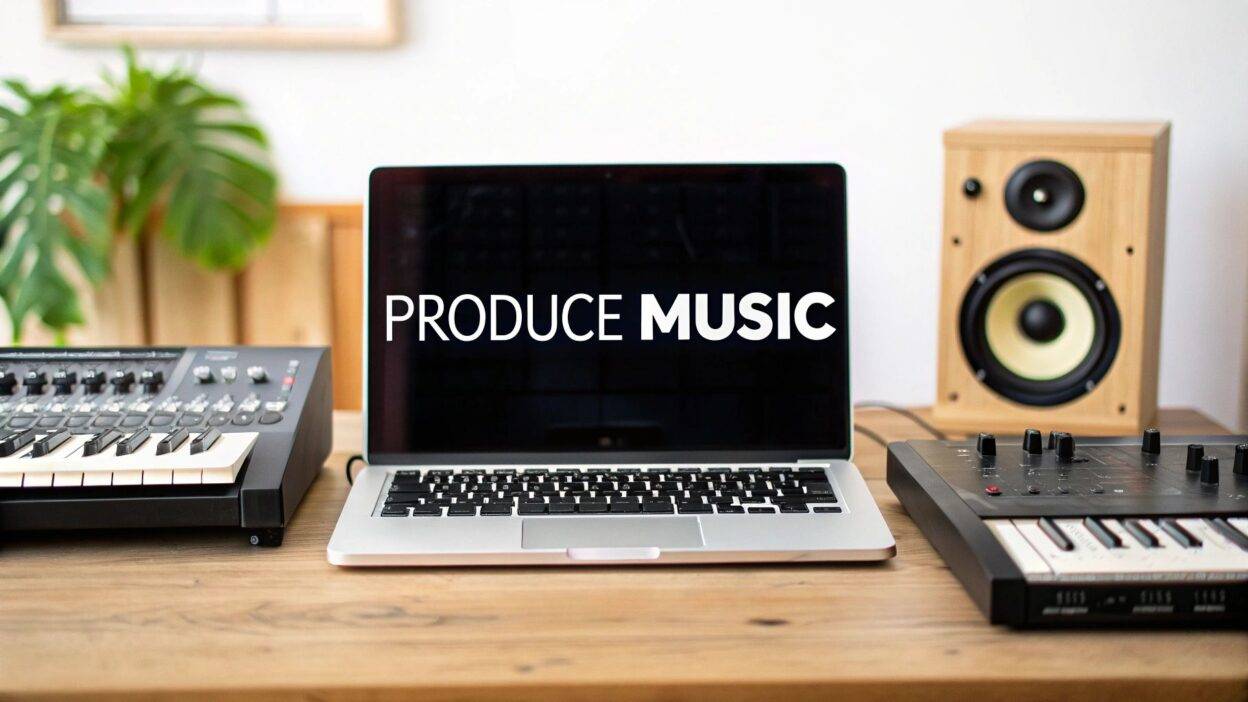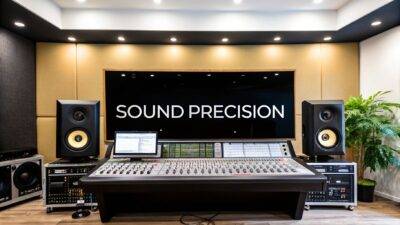Why Home Music Production Has Never Been More Accessible
The music industry has changed dramatically. While million-dollar studios were once the only option for professional sound, artists now create chart-topping hits from their homes. This shift towards home music production is a lasting change driven by technology and cultural factors. For many musicians, producing music at home is not only feasible but often the preferred choice.
The Rise of the Home Studio
One reason for this increasing accessibility is the affordability of powerful Digital Audio Workstations (DAWs) and recording equipment. High-quality laptops, affordable audio interfaces, and excellent microphones are now within reach for aspiring musicians. This empowers independent artists to control their creative vision without the high cost of traditional studio time. Furthermore, abundant online resources offer tutorials and collaborative opportunities, fostering a supportive community for home producers.
This growth is evident in market trends. Advancements in digital music production systems have made home music production increasingly affordable. The global music production system market is expected to grow from $6.42 billion in 2024 to $7.01 billion in 2025, a CAGR of 9.2%. Factors like the rise of DJ software, growth in streaming services, and the increase in home studios all contribute to this expansion. More detailed statistics can be found here: Music Production System Market Share
The following infographic shows the key benefits of home production, broken down by percentage.

As the infographic shows, cost savings (40%) are the most significant advantage, followed by creative freedom (35%) and the convenience of working from home (25%). These combined advantages allow artists to experiment, hone their skills, and produce authentic music on their terms, contributing to a diverse and vibrant independent music scene.
To further illustrate the differences between home and professional studio setups, let's look at a detailed comparison.
Home Studio vs Professional Studio Comparison: A detailed comparison of costs, accessibility, and creative freedom between home and professional studio setups
| Aspect | Home Studio | Professional Studio | Advantage |
|---|---|---|---|
| Cost | Low (equipment purchase) | High (hourly rates, engineer fees) | Home Studio |
| Accessibility | 24/7 availability | Limited by booking schedules | Home Studio |
| Creative Freedom | Full control over creative decisions | Potential influence from engineers/producers | Home Studio |
| Sound Quality | Can achieve high quality with proper equipment and knowledge | Generally higher due to superior acoustics and equipment | Professional Studio |
| Collaboration | More challenging for in-person collaboration | Easier for in-person collaboration with other musicians and engineers | Professional Studio |
| Learning Curve | Requires self-education and experimentation | Benefit from experienced engineers and producers | Professional Studio |
This table highlights the core differences between the two options. While professional studios still offer advantages in terms of sound quality and collaborative opportunities, home studios provide significant benefits in cost, accessibility, and creative control. This makes home production an ideal starting point for many aspiring musicians.
Creative Control and Authentic Expression
Home studios give artists unparalleled creative control, extending beyond the music itself. Artists can experiment with various sounds, arrangements, and production techniques without the time limits and financial pressures of a professional setting. This allows them to fully realize their creative vision, leading to more authentic and unique musical expressions. It also fosters collaboration and experimentation within the independent music scene.
Building Your Essential Home Studio Equipment Arsenal
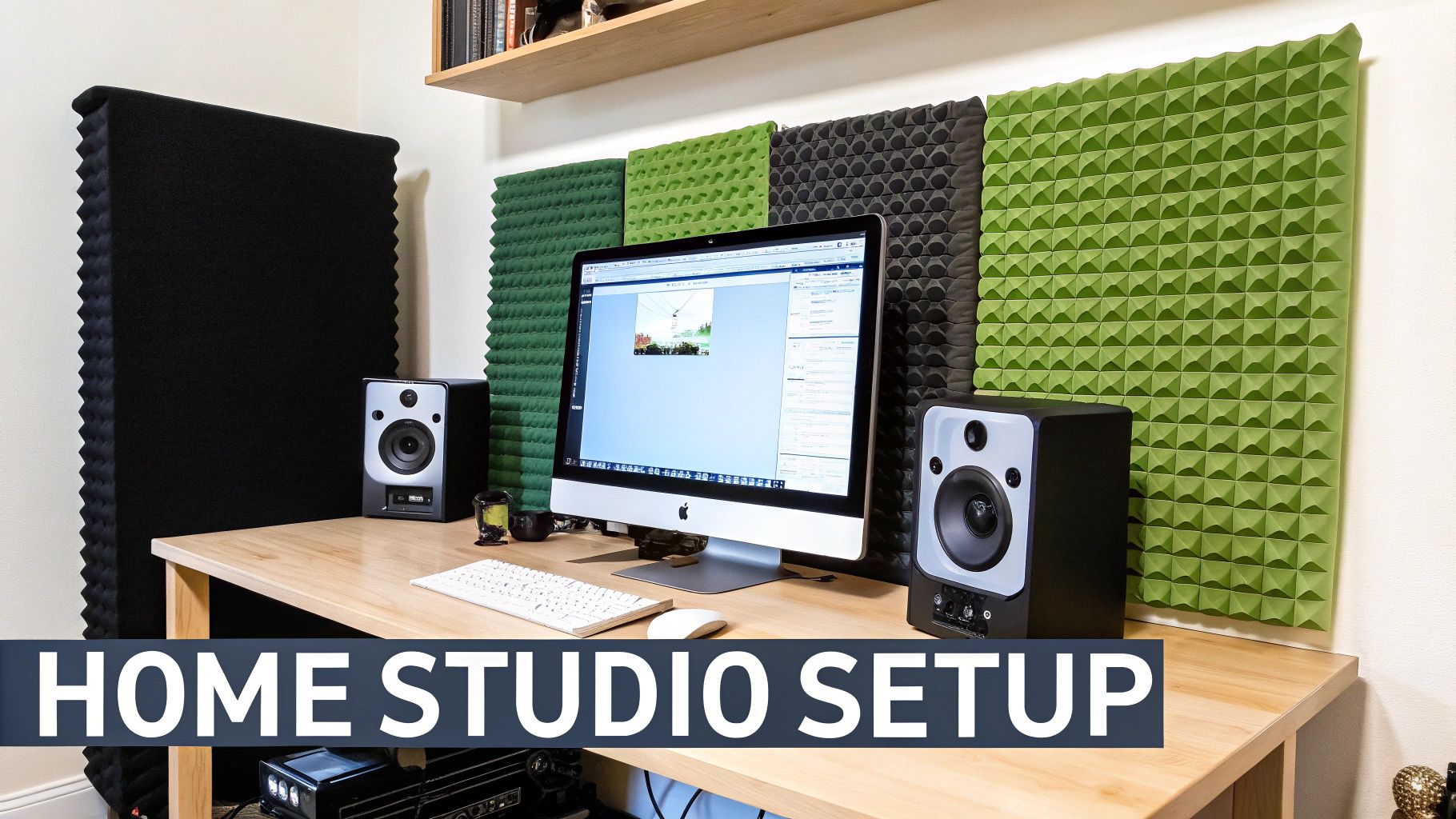
Creating music from the comfort of your home has never been easier. However, the sheer volume of available studio equipment can feel daunting. This guide will help you build a practical home studio without overspending, prioritizing quality over marketing hype. We'll focus on core components that offer real value, empowering you to produce professional-sounding music. This involves making smart purchases and maximizing your equipment's potential.
The Core Components of a Home Studio
Every productive home studio relies on a few essential pieces of equipment. These form the backbone of your setup and are vital for high-quality recordings. An audio interface, for instance, acts as the link between your instruments and computer. It converts analog audio signals into the digital information your DAW (Digital Audio Workstation) can process.
Likewise, studio monitors are specialized speakers engineered for precise sound reproduction, essential for informed mixing decisions. They let you hear your music accurately, revealing any imperfections that need attention.
- Audio Interface: Crucial for connecting microphones and instruments to your computer.
- Studio Monitors: Deliver accurate sound reproduction for critical listening and mixing.
- DAW (Digital Audio Workstation): Your central hub for recording, editing, and arranging music. (More on this in later sections.)
- Microphone: Captures vocals and acoustic instruments. Even a budget-friendly microphone can produce excellent results with the right technique.
- Headphones: Essential for recording and detailed mixing, particularly in shared living spaces.
Strategic Purchasing and Budget Optimization
Building a home studio is a continuous journey. There's no need to buy everything at once. Start with the essentials and upgrade as your skills and budget grow. This lets you invest in high-impact items first. Prioritize quality over quantity. A few well-made pieces of equipment will produce far better results than a collection of cheaper gear. You might find this helpful: How to master the basics of music production.
Acoustic Treatment and Room Optimization
Your recording space's acoustics significantly influence the quality of your recordings and mixes. Even a small room can become a professional recording environment with proper acoustic treatment. For example, strategically placed bass traps minimize low-frequency buildup in corners. Acoustic panels absorb sound reflections, creating a more controlled listening environment. This ensures clean recordings and mixes that translate well to other playback systems.
- Bass Traps: Reduce low-frequency buildup in corners, leading to improved clarity and definition.
- Acoustic Panels: Absorb sound reflections, resulting in a more neutral listening environment.
- Diffusers: Scatter sound waves, enhancing stereo imaging and reducing unwanted echoes.
To help you choose the right equipment based on your budget, take a look at the table below.
Essential Home Studio Equipment by Budget
Equipment recommendations organized by budget tiers from beginner ($500) to professional ($5000+)
| Equipment Type | Budget Option | Mid-Range Option | Professional Option | Priority Level |
|---|---|---|---|---|
| Audio Interface | Focusrite Scarlett Solo | Universal Audio Apollo Twin X | Antelope Audio Orion Studio Synergy Core | High |
| Studio Monitors | PreSonus Eris E3.5 | Yamaha HS5 | Focal Shape Twin | High |
| DAW (Digital Audio Workstation) | Cakewalk by BandLab (Free) | Ableton Live 11 Intro | Avid Pro Tools | High |
| Microphone | Audio-Technica AT2020 | Rode NT1-A | Neumann U87 Ai | Medium |
| Headphones | Audio-Technica ATH-M20x | Beyerdynamic DT 770 Pro | Sennheiser HD 800 S | Medium |
| Bass Traps | DIY or Foam Panels | Primacoustic London Bass Traps | GIK Acoustics 244 Bass Traps | Medium |
| Acoustic Panels | Auralex Studiofoam | ATS Acoustics Panels | Vicoustic Wavewood | Low |
| Diffusers | DIY or Foam Diffusers | Auralex T'Fusor | Vicoustic Multifuser DC2 | Low |
This table provides a starting point for equipping your home studio. As you can see, prioritizing your audio interface, studio monitors, and DAW is crucial for any budget. Microphones and headphones are next in line, followed by acoustic treatment options.
Producing great music at home doesn't require a fortune. By understanding your needs and making smart choices, you can build a powerful studio on a budget, unlocking your creative potential and achieving professional results.
Choosing Your Digital Audio Workstation Like a Pro
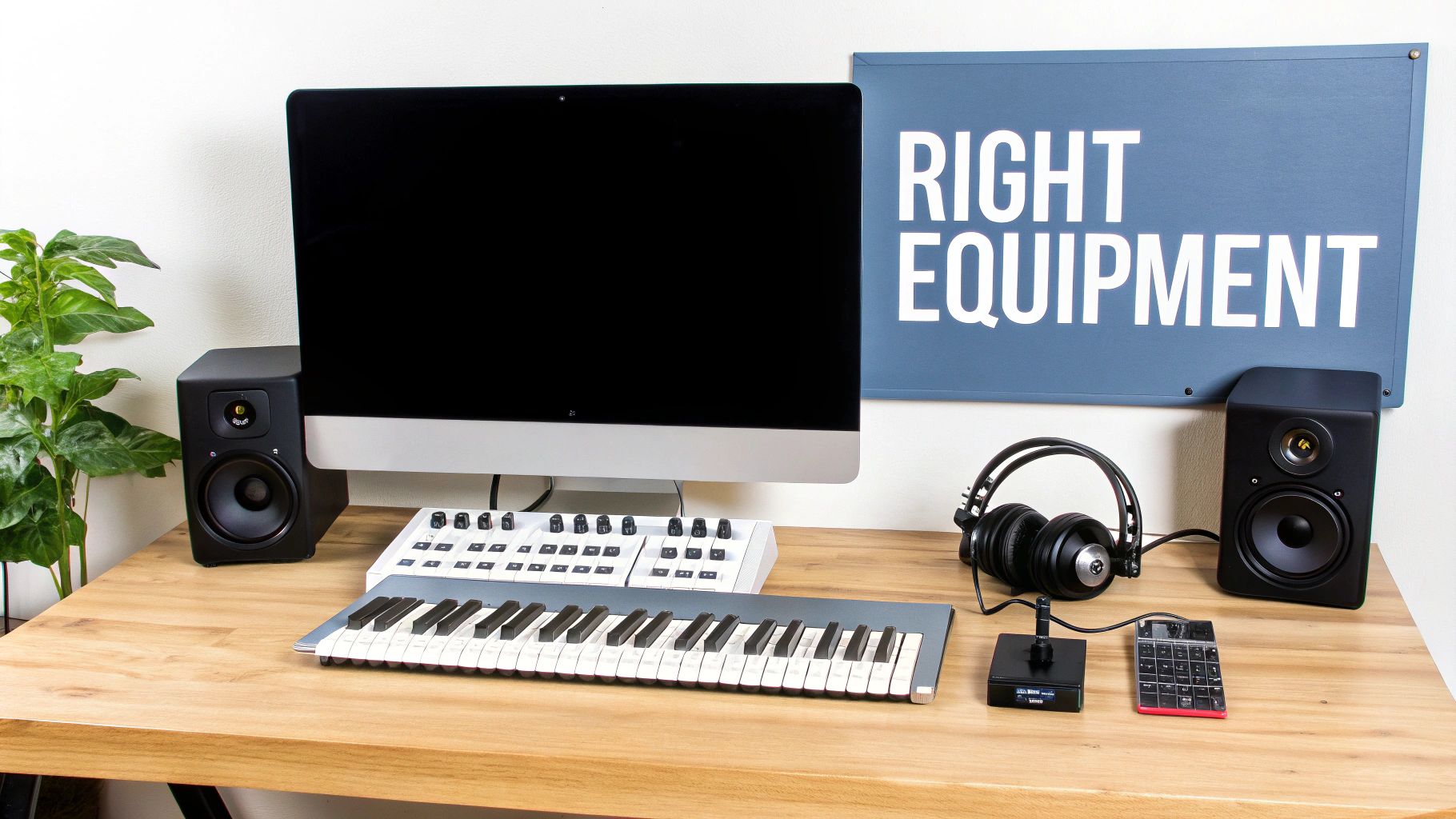
So you're ready to embark on your home music production journey. You've gathered your equipment, and now comes a critical decision: selecting your Digital Audio Workstation (DAW). This software becomes your creative center, where you'll record, edit, mix, and master your music. With a wide array of options available, finding the right one can feel overwhelming. This section simplifies the process, helping you choose the perfect DAW for your needs.
Matching Your DAW to Your Style
Choosing a DAW isn't a one-size-fits-all endeavor. Each DAW has its strengths, catering to different production styles and skill levels. For instance, Ableton Live is known for its loop-based workflow, making it a favorite for electronic music producers and live performers.
Ableton Live offers an intuitive interface for creating music quickly. On the other hand, Logic Pro X is often preferred by composers and songwriters for its vast library of virtual instruments and effects. Pro Tools, a long-standing industry standard, is designed for professional recording and mixing in studio environments. For beginners, exploring resources like the best music production programs for beginners can provide valuable insights.
Essential Features vs. Flashy Extras
While new features are constantly being introduced, it's the core functionality that truly matters. Prioritize a user-friendly interface, robust recording and editing tools, a powerful mixer, and a good selection of virtual instruments and effects. These core elements form the foundation of a productive workflow.
Considering the Long-Term Investment
Think about your current needs and future goals. Some platforms offer affordable entry-level versions, which is excellent for beginners. However, consider potential upgrade costs and limitations if your aims extend beyond basic home production.
The music production software market is experiencing substantial growth, projected to increase by USD 432.8 million between 2025 and 2029. This represents a CAGR of almost 7.7%, driven by the rising number of musicians and the growing integration of AI in music creation. You can find detailed statistics here.
Learning Curve and Built-in Content
DAWs have varying learning curves. Some are designed for intuitive use, while others, with advanced features, may require more time to master. The quality and quantity of built-in content, like virtual instruments, loops, and samples, can significantly impact your production process, especially when starting. Choosing a DAW with a suitable learning curve and relevant built-in content can streamline your workflow.
Transforming Any Space Into a Production Powerhouse
Your bedroom can become a surprisingly effective music production studio. With the right techniques, even small spaces can rival expensive professional facilities. Successful home producers know how to optimize their environment, regardless of size or limitations. This section reveals practical, evidence-based methods for controlling acoustics and maximizing your room’s potential.
Acoustic Treatment: Taming Your Room’s Sound
Acoustic treatment is key for professional-sounding music at home. It involves using materials to control sound reflections and minimize unwanted noise. The goal isn't silence, but shaping the sound for accurate listening.
-
Bass Traps: These address low-frequency buildup, common in small rooms. Placing them in corners, where bass accumulates, improves clarity and definition.
-
Acoustic Panels: These absorb mid- and high-frequency reflections, creating a neutral listening environment. This helps you hear your mix accurately, preventing flawed decisions based on distorted room acoustics.
-
Diffusers: Unlike absorbers, diffusers scatter sound waves, preventing flutter echoes and creating a natural sense of space. They enhance stereo imaging and add depth.
These materials are easily found at most hardware stores, making effective acoustic treatment affordable.
Positioning for Optimal Sound: Maximizing Your Space
Even with acoustic treatment, speaker and listening position are crucial. The "38% rule" suggests placing your listening position 38% of the room's length from the front wall. This minimizes negative interactions between sound waves and boundaries. Positioning monitors equidistant from each other and your listening position creates a balanced stereo image.
Creative Solutions for Small Spaces
Many home producers work in challenging environments. Producers in bedrooms often combine recording and mixing in the same small area. Creative solutions like portable vocal booths or strategically placed acoustic screens create separation and minimize bleed between instruments.
Ergonomics: Maintaining Comfort and Creative Flow
Long production sessions can be physically demanding. Ergonomics are essential for comfort and preventing fatigue. Invest in a supportive chair and adjust your desk and monitor height to avoid strain. Regular breaks and stretching also help maintain focus and creativity during long production periods. These ergonomic strategies ensure effective work without physical sacrifice. By creating a comfortable and acoustically optimized space, you transform any room into a powerful music production environment, unleashing your creative potential and achieving professional results.
Mastering The Fundamentals That Separate Pros From Amateurs
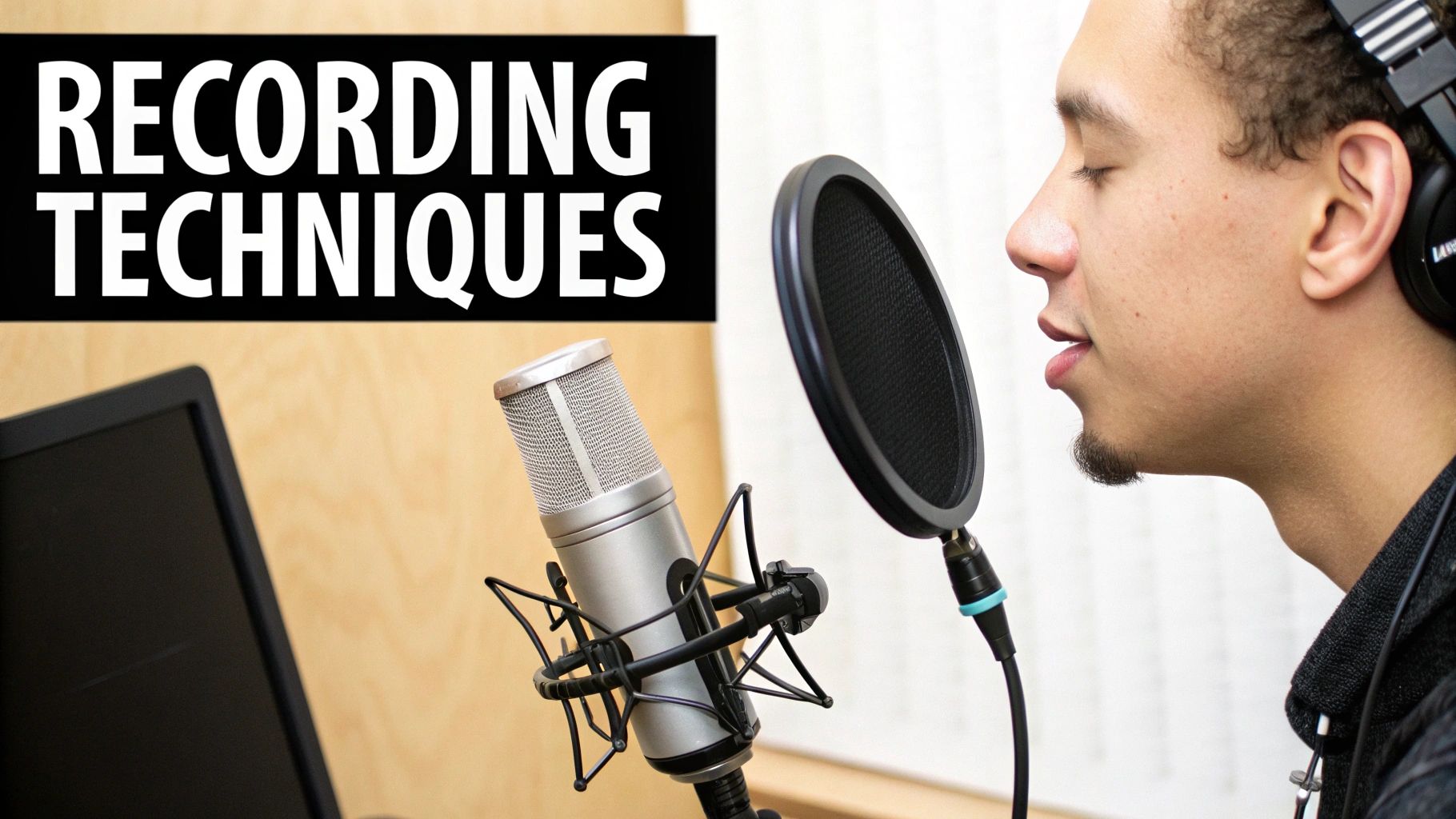
Producing music at home is more than just acquiring the latest gear and software. It's about understanding the core principles that distinguish a professional sound from an amateur one. Mastering these fundamentals can elevate your music from simple recordings to truly captivating tracks. This means focusing on the elements that engage the listener, not just the technical aspects.
Music Theory In Practice: More Than Just Textbooks
Music theory can seem intimidating, but its practical application in home production is essential. This isn't about complex academic study, but rather grasping how chords interact, how melodies complement harmonies, and how rhythm drives the music forward. Understanding how major and minor chords evoke different emotions, for instance, can significantly impact your songwriting. Similarly, a grasp of basic rhythmic patterns can make your music feel more organic and engaging.
Arrangement Strategies: Keeping Listeners Hooked
Beyond notes and chords, the arrangement of your music is vital for holding your listener's attention. This involves strategically structuring sections, creating smooth transitions, and introducing variations to avoid monotony. Think of your song like a story: it needs a beginning, rising action, a climax, and a resolution. Structuring your music thoughtfully helps avoid repetition and keeps the listener engaged. You might be interested in: Essential Music Production Advice for Beginners.
Mixing Approaches: The Polish That Makes A Difference
A well-polished mix elevates a track, giving it a professional sheen. This involves balancing levels, using EQ to shape individual sounds, applying compression to control dynamics, and using reverb and delay to create a sense of space. The goal isn't just loudness, but clarity and balance, ensuring each element has its place in the mix. For example, excessive reverb can muddy the sound, while too little can make it feel dry and lifeless. Mastering these tools is key to achieving a professional sound.
Developing Your Ear: The Key To Quality
Successful home producers cultivate a keen ear for quality. They learn to discern subtle nuances in sound, recognize a balanced mix, and know when a track is truly complete. This isn't about perfect pitch, but about training yourself to hear details and make informed decisions. It's about understanding how individual elements interact to create a cohesive and satisfying whole. This skill develops over time through consistent practice and critical listening.
Dynamics And Space: Creating Impact And Emotion
Modern music production hinges on the effective use of dynamics and space. Dynamics refers to the variations in volume within a track, creating contrast and impact. Space, created with effects like reverb and delay, adds depth and atmosphere. Understanding these tools will transform your mixes, giving them a more professional feel. It's about creating a soundscape that draws the listener in, enhancing the emotional impact of the music. Mastering these fundamentals empowers you to take your productions to the next level through continuous learning, experimentation, and pushing your creative boundaries.
Creating Your First Complete Track From Start to Finish
Now that your DAW is selected and your home studio is ready, it's time to create your first complete track. This section guides you through a reliable workflow, from initial idea to finished product. It's about moving beyond simply owning the tools and building a sustainable process.
Capturing Inspiration and Building Your Foundation
The first step is capturing your initial musical idea. This might be a melody, chord progression, drum beat, or even a general feeling. Use your DAW to quickly record these ideas before they're lost. Try humming a melody into your phone's voice recorder or playing it on a keyboard and recording directly into your DAW. This initial idea becomes the foundation of your track.
Structuring Your Track: Arrangement and Flow
Once you have your core idea, it's time to structure the track. This means arranging sections like the intro, verse, chorus, bridge, and outro. Imagine building a house: you start with the foundation and add layers. Experiment with arrangements and transitions to create a dynamic flow. This often involves looping sections and adding variations to create a complete song structure.
Adding Layers: Instrumentation and Sound Design
With the arrangement set, start adding layers of instrumentation. This could be recording vocals and instruments, or using virtual instruments within your DAW. Explore different sounds and textures to complement your core idea. This stage lets your creativity shine and your unique sound develop. Consider which instruments will create the desired atmosphere and emotion.
Mixing and Mastering: Refining Your Sound
After recording and arranging, you'll move into mixing and mastering. Mixing balances the levels of different tracks, applying EQ, compression, and other effects to create a cohesive sound. Think of it like blending ingredients in a recipe. Mastering is the final polish, optimizing the mix for different playback systems. It's the final touch that prepares your music for sharing.
Maintaining Momentum and Overcoming Challenges
Creating a complete track is a journey, and staying motivated is crucial. Set realistic goals, break large tasks into smaller steps, and celebrate your progress. Consistency is essential, just like running a marathon. Embrace the learning process. Don't be discouraged by challenges; see them as opportunities to grow and improve your skills. These tips will help you develop a sustainable production process for creating music efficiently and with consistently improving quality.
Scaling Your Home Production Skills to Professional Level
So, you’ve mastered the basics of home music production. You’re comfortable with your DAW, your equipment is set up, and you’re creating tracks you’re proud of. What’s next? This section explores how to elevate those home production skills to a professional level, bridging the gap between bedroom hobbyist and industry-recognized artist. This involves refining your techniques, understanding the industry, and adopting a professional mindset.
The Mindset Shift: Thinking Like a Pro
One key difference between a hobbyist and a professional is mindset. Professionals treat their music production like a business. They focus on consistent output, quality control, and meeting deadlines. This means setting clear goals, developing a structured workflow, and continuously seeking improvement.
Regularly analyzing your tracks, seeking feedback from trusted sources, and studying the work of successful producers are crucial practices. This continuous learning process is essential for growth and refinement.
Distribution and Reaching Your Target Audience
The digital music revolution has democratized music distribution. Platforms like Spotify, Apple Music, and Bandcamp allow independent artists to reach a global audience. However, simply uploading your music isn't enough.
Effective distribution involves strategic planning, understanding your target audience, and actively promoting your music. This includes building an online presence, engaging with fans on social media, and exploring opportunities for collaboration. Connecting with other artists and building a supportive network is invaluable in today’s interconnected music scene.
Emerging Technologies and Creative Possibilities
Technology continues to reshape music production. AI-powered tools, virtual reality experiences, and immersive audio formats offer new creative possibilities. Staying informed about these advancements and experimenting with new tools can help you stay ahead of the curve. This willingness to embrace innovation can lead to unique sounds and expand your creative horizons.
However, it’s essential to remember that technology is a tool. The core of compelling music remains strong songwriting, impactful arrangements, and polished production. The global music industry is projected to be worth $65.45 billion in 2025, with the digital music sector reaching $29 billion. This growth, driven by streaming and social media, highlights the expanding opportunities for independent artists. Find more detailed statistics here: Music Industry Stats.
Sustainable Practices for Long-Term Success
Building a sustainable career in music requires more than just talent. It involves developing healthy habits, managing your time effectively, and cultivating a strong work ethic. Setting realistic goals, prioritizing your mental and physical well-being, and fostering a positive mindset are crucial for long-term success.
This balance between creativity and practicality is essential for navigating the ever-evolving music industry. This holistic approach will prepare you for the demands of a professional career, ensuring you can continue to create and thrive within the dynamic music landscape. Ready to take your music production to the next level? ChordX provides the resources and guidance you need to succeed. Visit ChordX today and unlock your full creative potential.
